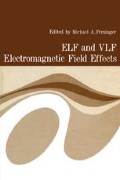Abstract
Electromagnetic fields of extremely low frequency have been shown at a high statistical level to influence human circadian rhythms. This means that circadian rhythms can be used as very sensitive indicators to test the influence of ELF electromagnetic fields on human beings in general. Before discussing the special ELF-effects, the indicator itself has to be introduced. Therefore, some basic features of human circadian rhythms will be mentioned.
Access this chapter
Tax calculation will be finalised at checkout
Purchases are for personal use only
Preview
Unable to display preview. Download preview PDF.
References
ASCHOFF, J., Comparative Physiology: Diurnal Rhythms. Ann. Rev. Thysiol., 25: 581–600, 1963.
ASCHOFF, J., Tagesperiodik licht- und dunkelaktiver Tiere. Revue Suisse Zool., 71: 528–558, 1964.
ASCHOFF, J., Internal Dissociation and Desynchronization of Circadian Systems. Proc, XXIst. Int, Cong. Aviation and Space Medicine, p. 255, 1973.
ASCHOFF, J., GERECKE, U., KURECK, A., POHL, H., RIEGER P., SAINT PAUL, U., WEVER, R., Interdependent Parameters of Circadian Activity Rhythms in Birds and Man, In: Bioöhronometry (ed.: M. Menaker), Washington, D.C., 1971.
ASCHOFF, J., GERECKE, U., WEVER, R., Phasenbeziehungen zwischen den circadianen Perioden der Aktivität und der Kertemperatur beim Menschen.Pflügers Arch., 295: 173–183, 1967a.
ASCHOFF, J., GERECKE, U., WEVER, R., Desynchronization of Human Circadian Rhythms, Jap. J. Physiol., 17: 450–457, 1967b.
ASCHOFF, J., PÖPPEL, E., WEVER, R., Circadiane Periodik des Menschen unter dem Einfluß von Licht-Dunkel-Wechseln unterschiedlicher Periode.Pflügers Arch., 306: 58–70, 1969.
ASCHOFF, J., v. SAINT-PAUL, U., WEVER, R., Circadiane Periodik von Finkenvögeln unter dem Einfluss eines selbstgewählten Licht-Dunkel-Wechsels. Z. vergl. Physiol., 58: 304–321, 1968.
ASCHOFF, J., WEVER, R., Spontanperiodik des Menschen bei Ausschlug aller Zeitgeber.Naturwissensohaften, 49: 337–342, 1962.
CONROY, R.T.W.L., MILLS, J.N., Human Civoadian Rhythms, London, 1970.
HALBERG, F., Physiologie 24-hour Periodicity: General and Procedural Considerations with Reference to the Adrenal Cycle. Z. Vitamin- Hormon- und Ferment forsohung, 10: 225–296, 1959.
KÖNIG, H., Atmospherics geringster Frequenzen. Z. angew. Physik, 11, 264–274, 1959.
MILLS, J.N., MINORS, D.S., WATERHOUSE, J.M., Periods of Different Components of Human Circadian Rhythms in Free-running Experiments. Proc, Xlth. Int. Conf. Chronohiologyy (in print).
ROHRACHER, H., Mechanische Mikroschwingungen des menschlichen Körpers. Wien, 1949.
ROHRACHER, H., INANAGA, K., Die Mikrovihration. Bern, 1969.
WEVER, R., A Mathematical Model for Circadian Rythms. In: Circadian Clocks, (ed.: J. Aschoff), pp. 47–63, Amsterdam, 1965.
WEVER, R., Ein mathematisches Modell für die circadiane Periodik. Z. angew. Math. Mech. 46: T 148–157, 1966.
WEVER, R., Gesetzmässigkeiten circadianer Aktivitäts-Rhythmen bei Tier und Mensch. In: La distribution temporelle des activites animales et humaines, (ed.: J. Medioni), pp. 3–17, Paris, 1967a.
WEVER, R., Uber die Beeinflussung der circadianen Periodik ees Menschen durch schwache elektromagnetische Felder. Z. vergl. Physiol. 56: 111–128, 1967b.
WEVER, R., Einfluss schwacher elektro-magnetischer Felder auf die circadiane Periodik des Menschen. Naturwissenschaften, 55: 29–32, 1968a.
WEVER, R., Mathematical Model of Circadian Rhythms and their Applicability to Men. In: Cycles biotogiques et psychiatrie, (ed.: J. de Ajuriaguerra), pp. 61–72, Paris, 1968b.
WEVER, R., Gesetzmässigkeiten der circadianen Periodik des Menschen, geprüft an der Wirkung eines schwachen elektrischen Wechselfeldes.Pflügers Arch. 302: 97–122, 1968c.
WEVER, R., Autonome circadiane Periodik des Menschen unter dem Einfluss verschiedener Beleuchtungs-Bedingungen. Pflügers Arch. 206: 71–91, 1969a.
WEVER, R., Untersuchungen zur circadianen Periodik des Menschen mit besonderer Berücksichtigung des Einflusses schwacher elektrischer Wechselfelder. Bundesminst. f. wiss. Forschg., Forschungshericht. W 69–31, 212pp. 1969b
WEVER, R., The Effects of Electric Fields on Circadian Rhythms in Man. Life Sciences and Space Research, 8: 177–187, 1970a.
WEVER, R., Die gegenseitige Kopplung zwischen den circadianen Periodizitäten verschiedener vegetativer Funktionen beim Menschen. Pflügers Arch. 319: R 122, 1970b.
WEVER, R., Zur Zeitgeber-Stärke eines Licht-Dunkel-Wechsels für die circadiane Periodik des Menschen.Pflügers Arch. 321: 133–142, 1970c.
WEVER, R., Die circadiane Periodik des Menschen als Indikator für die biologische Wirkung elektromagnetischer Felder. Z.Physik. Med. 2: 439–471, 1971a.
WEVER, R., Influence of Electric Fields on Some Parameters of Circadian Rhythms in Man. In: Biochronometry (ed.: M. Menaker), pp. 117–132, Washington, D.C., 1971b.
WEVER, R., Mutual Relations between Different Physiological Functions in Circadian Rhythms in Man, J. Interdiscipl, Cycle Res. 3: 253–265, 1972.
WEVER, R., Hat der Mensch nur eine “innere Uhr”? Umschau in Wissenschaft und Technik. 73: 551–558, 1973.
WEVER, R., Circadian Rhythms in Human Performance. In: Sleep, Drugsy and Performance (ed.: St. A. Lewis), in printa.
WEVER, R., Der Einfluss des Lichtes auf die circadiane Periodik des Menschen. Z.Physik. Med.:, in printb.
Author information
Authors and Affiliations
Editor information
Editors and Affiliations
Rights and permissions
Copyright information
© 1974 Plenum Press, New York
About this chapter
Cite this chapter
Wever, R. (1974). ELF-Effects on Human Circadian Rhythms. In: Persinger, M.A. (eds) ELF and VLF Electromagnetic Field Effects. Springer, Boston, MA. https://doi.org/10.1007/978-1-4684-9004-6_5
Download citation
DOI: https://doi.org/10.1007/978-1-4684-9004-6_5
Publisher Name: Springer, Boston, MA
Print ISBN: 978-1-4684-9006-0
Online ISBN: 978-1-4684-9004-6
eBook Packages: Springer Book Archive

